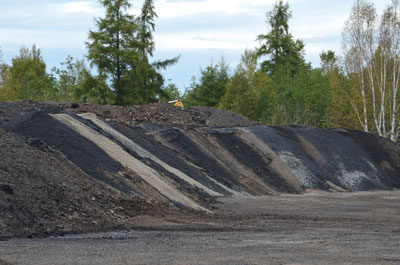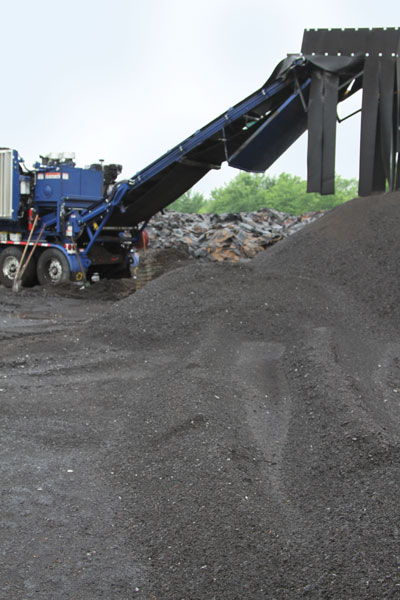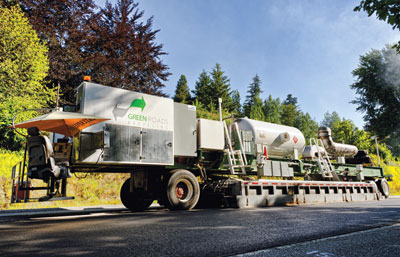
Features
Roads & Paving
Technology
State of the RAP Industry III
Extent of RAP use in Canada.
October 12, 2012 By Treena Hein
In our previous issue, we took a close look at the technologies
contributing to the increased use of reclaimed asphalt pavement (RAP) as
well as recycled asphalt shingle material.
In our previous issue, we took a close look at the technologies contributing to the increased use of reclaimed asphalt pavement (RAP) as well as recycled asphalt shingle material. Use of RAP has come a long way – it is now fractionated into multiple sizes and treated similarly to virgin aggregate – but how much is RAP now in use across Canada and what is affecting extent of use?
 |
|
| RAP is taken back to the contractor’s yard before being ground for use on a highway road project.
|
“The actual amount of RAP used in Ontario is a hard number to determine,” says Ontario Hot Mix Producers Association technical director Sandy Brown. “There are no official surveys of usage provided by the industry or agencies.” Some jurisdictions, he notes, do not allow RAP, and others allow up to 20% in surface lifts and as much as 50% in binder lifts.
However, Brown stresses that the amount of RAP allowed in a mix should not be confused with the amount that is actually recycled. “Virtually 100% of the asphalt pavement removed from roadways in Ontario is reused or recycled,” he explains. Ministry of Transportation in Ontario (MTO) senior media officer Bob Nichols confirms that provincial policy allows 100% of the RAP generated on a contract to be made available to the contractor, “who reuses it to its highest possible value, either in MTO contracts or in municipal or private applications.” Nichols says this policy has been in place for more than 10 years, and that MTO anticipates no change in making all RAP available to the contractor for recycling purposes. “Recycling of all reclaimed asphalt material is not mandatory, but is strongly encouraged on all Ministry contracts,” he says, adding that the vast majority of Ontario’s paving contractors and suppliers already routinely incorporate RAP into their hot mix asphalt (HMA) production.
“About 15% is reused in Ontario in the granular layers either by in-place rehabilitation techniques – cold-in-place recycling (CIR) of the HMA layers with the addition of minor amounts of new asphalt binder,” says Brown, “or full-depth reclamation (FDR) of the HMA layers and the underlying granular material with or without the use of additional asphalt binder.” Included in this 15% is RAP that’s used for things like granular shouldering.
“Nonetheless, the best and highest use for RAP from an environmental and economic viewpoint would be to recycle the material into new HMA,” Brown asserts.
MTO increased its allowance for RAP in 2010 because, Brown says, they had good experiences with using it in paving Highway 401 over the years (the major highway along southern Ontario). The Ministry now allows up to 20% in all surface courses (except premium surface courses) and 40% in binder lifts. “MTO is convinced,” says Brown, “and now we just need to convince the other lower-tier jurisdictions in Ontario that they have to follow MTO’s lead.” Indeed, Brown states, “MTO is ramping up its in-place remediation techniques in an effort to have ‘the greenest roads in North America.’”
Nichols confirms that MTO is promoting pavement recycling through CIR, CIR with Expanded Asphalt Modifier (CIREAM), Hot In-Place recycling (HIR), FDR and Expanded Asphalt Stabilization (EAS). “Quantities of MTO in-place recycling vary significantly from year to year depending on the Ministry’s construction program,” Nichols explains. “From 2001 to 2010, the Ministry carried out approximately 10 million m2 of CIR, CIREAM, and FDR with EAS,” with total paving during that time estimated to have been 110 million m2. There was one 34.5 kilometre-long HIR project carried out in 2003 that totalled 342,000 m2.
The use of Warm Mix Asphalt (WMA) technology in MTO contracts is also allowing for incorporation of higher RAP contents in the mix. “This is [also] currently being explored by the Ministry,” notes Nichol. “Improvements in in-place recycling equipment, methods and additives will further increase the use of these sustainable asphalt recycling treatments.”
Alberta
Contractors in Alberta now incorporate RAP in about half of the total amount of asphalt mix used in the province. “This has increased over the past five to 10 years as binder prices increase, and it’s at a point where almost all asphalt reclaimed on a project is recycled,” notes Alberta Transportation (AT) Technical Standards Branch executive director Moh Lali. “On AT projects, a majority of any RAP is already recycled.” Because of the high value of RAP and because the province has passed legislation forbidding the land-filling of recyclable materials such as asphalt and concrete, Lali says, the Ministry does not expect to see any RAP go unutilized, and therefore does not anticipate that the province will make asphalt recycling mandatory.
 |
|
| Grinding equipment is used to break the asphalt into the spec needed by the paving contractor.
|
However, as is the case in Ontario, Lali believes technological developments and the use of WMA will potentially increase RAP ratios further.
“Contractors and manufacturers are constantly innovating to better utilize RAP,” he says. These include counter-flow plants and double-barrel asphalt plants, which have allowed contractors to add up to 50% RAP in Alberta, says Roger Walls, past chair of the Alberta Roadbuilders and Heavy Construction Association and the owner of Border Paving Ltd. in Red Deer. His company uses 15 to 20% RAP. In-place recycling, notes Walls, is also beginning to make inroads in Alberta.
Trials using CIR and FDR have been held recently, for example, in the City of Edmonton. Approximately 95% of all asphalt placed in that community contains an RAP component. Within the city, ACO (overlay surface hot mix) can contain 10% RAP, ACR (residential surface hot mix) can have 20% RAP, and ACB (base course asphalt mix) can have up to 25%.
“We also incorporate 25% RAP into our recycled concrete aggregate,” says Hugh Donovan, construction services engineer with the City’s department of Transportation Services. “There really has not been much of an increase in RAP use over the past five to 10 years,” he notes, “[and] at this time, we do not foresee an increase in the limits set by the City.” Donovan says some other provincial agencies in other jurisdictions follow Edmonton’s lead with comparable quantities, while some use lower amounts of RAP.
British Columbia
Some municipalities in British Columbia allow 20% in base and top pavement layers, especially in subdivisions where there is lower traffic flow, but others have lower limits. The B.C. Ministry of Highways uses RAP in the majority of contracts. In sideroads, 30% RAP is permitted in the base layer, whereas a little is allowable in the top layer.
 |
|
| New equipment is being developed to meet the demands of the RAP industry, including GreenRoads Recycling’s Super Postheater, seen here on the road in Nelson, B.C.
|
The amount of RAP that can be used on the top layer of pavement on B.C. highways has recently increased. “We held ongoing meetings with the contracting community last year,” notes Mike Oliver, the Ministry’s associate chief geotechnical materials and pavement engineer. “It was good to include the companies in this. Since November 2011, 10% RAP is allowed in the top layer. That will be reviewed on an ongoing basis and may increase.”
In terms of in-place asphalt recycling in British Columbia, there are three HIR companies currently placing bids for this work. “There is enough work to keep all three busy,” says Oliver. “The HIR workloads are all over the province.” He says the amount of HIR occurring in British Columbia has not changed much in the recent past.
In BC, the HIR process uses up to 20% new mix and a rejuvenator that enhances the aged asphalt cements in the RAP. “In fact, with the use of the 20% new mix, most HIR mix will meet specs for new mix,” Oliver observes. “The asphalt cement will meet specs for new asphalt cement as well.” He says the results provide “excellent smoothness and densities,” and that because of the high quality and the cost savings provided by HIR, “in the long run, companies should get more work.”
As oil becomes scarcer and environmental concerns mount, it’s clear that using RAP provides a win-win situation for all. Equipment technologies will continue to evolve, as will testing methods to determine things like the quality of RAP asphalt cement, and these developments are sure to move RAP ratios further upwards in all Canadian jurisdictions over time.
| RAP use in the United States No U.S. states currently mandate RAP use, notes Kent Hansen, director of engineering at the National Asphalt Pavement Association (NAPA). However, he says, “We expect the average percent of RAP used in asphalt mixes to increase.” Results from a survey conducted by NAPA and the Federal Highway Administration (FHWA) entitled ‘The Asphalt Pavement Mix Production Survey Reclaimed Asphalt Pavement, Reclaimed Asphalt Shingles, Warm-mix Asphalt Usage: 2009-2010’ showed that about 99% of all RAP is now being reused or recycled in highway applications, up from 80% almost 20 years ago (1993). “In 2005, a NAPA survey of contractors found that the average percent of RAP used in asphalt mixes was about 12.5%,” notes Hansen. “For 2009 and 2010, the NAPA/FHWA survey showed the average percent of RAP in asphalt mixes was 16.2 and 18.0%, respectively.” |
Print this page